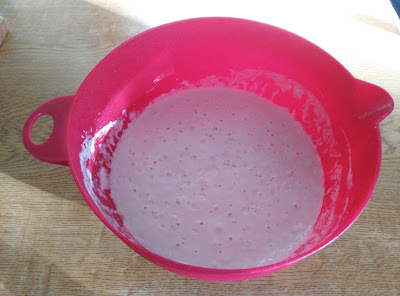I've recently been given a jar of sourdough starter. Many thanks Deano! To be honest, I wasn't exactly sure what to do with it at first and it looks a little like an old pot of paint I once found in the shed.
I have since found this article by Hugh Fearnley-Whittingstall that explains everything. To the uninitiated the "starter" is a way of cultivating wild yeast to use in your baking, adding the characteristic sour flavour to the bake. Every now and then you need to feed it (just flour and water) to keep it alive, and it starts to bubble up and become more active.
I have friends who bake that rave about sourdough and claim it makes the best bread. Apparently you can make amazing cakes, and pancakes too. Apparently Sourdough may be better for people with a Gluten intolerance and it may even have health benefits something that had never occurred to me.
So, I decided to see what all the fuss is about and give it a try. I fed the starter according to the instructions and left it to bubble away overnight.
The first stage in making the bread is to make what is called a Sponge using some of the starter. When I said what I was making it led to some confusion, and a touch of disappointment, in our household as some kind of cake was expected. And instead I made this...
It looks a bit like a kind of batter, but with a few more bubbles. The sponge needs to be left to activate (again overnight) before more flour, plus oil and salt is added to make a more conventional dough. At this point I was in more familiar territory. It was just like making any other bread although with a sourdough starter, rather than fast acting yeast, proving takes quite a bit longer. Patience is required.
I decided to keep things simple the first time, so didn't bother with a fancy pattern or shape, and didn't snip, slash or cut the top of the loaves either as was recommended. Here's my first attempt, two small loaves.
They tasted great with a slight hint of sourness but nothing too strong. The bread had a good crunchy crust (which made it quite difficult to slice) and a light, springy texture. I think I'd have been better off making one larger loaf than two small ones. We ate some of the bread straight away and then froze the remainder. It makes excellent toast and can be cooked straight from the freezer.
Making bread like this requires quite a bit of patience and a fair amount of forward planning, nearly every stage requires a good chunk of waiting time.
I shall keep experimenting, and try and refine my method, and post a full recipe at a later date.
As always let me know if you have any comments or suggestions.








No comments:
Post a Comment